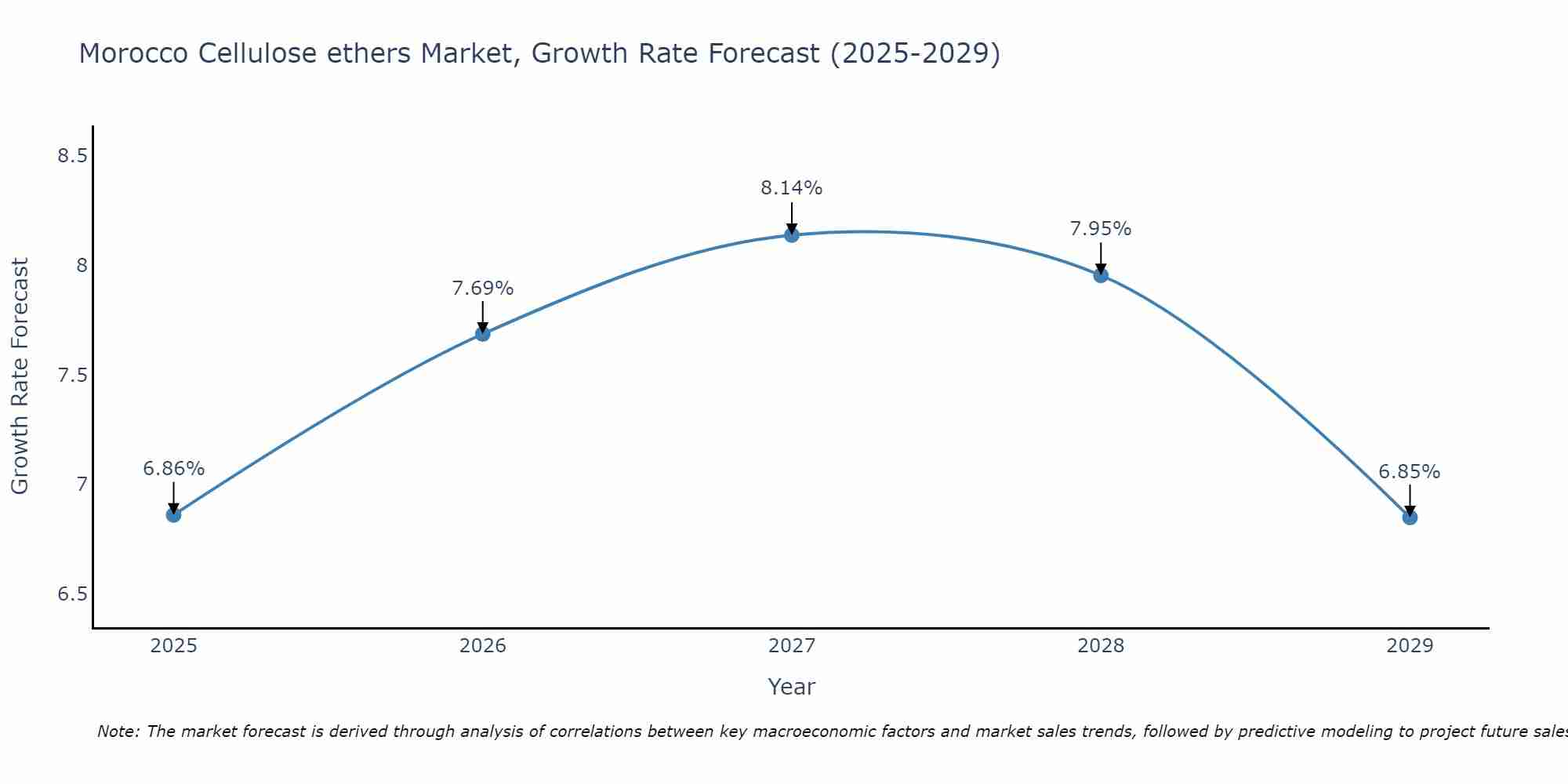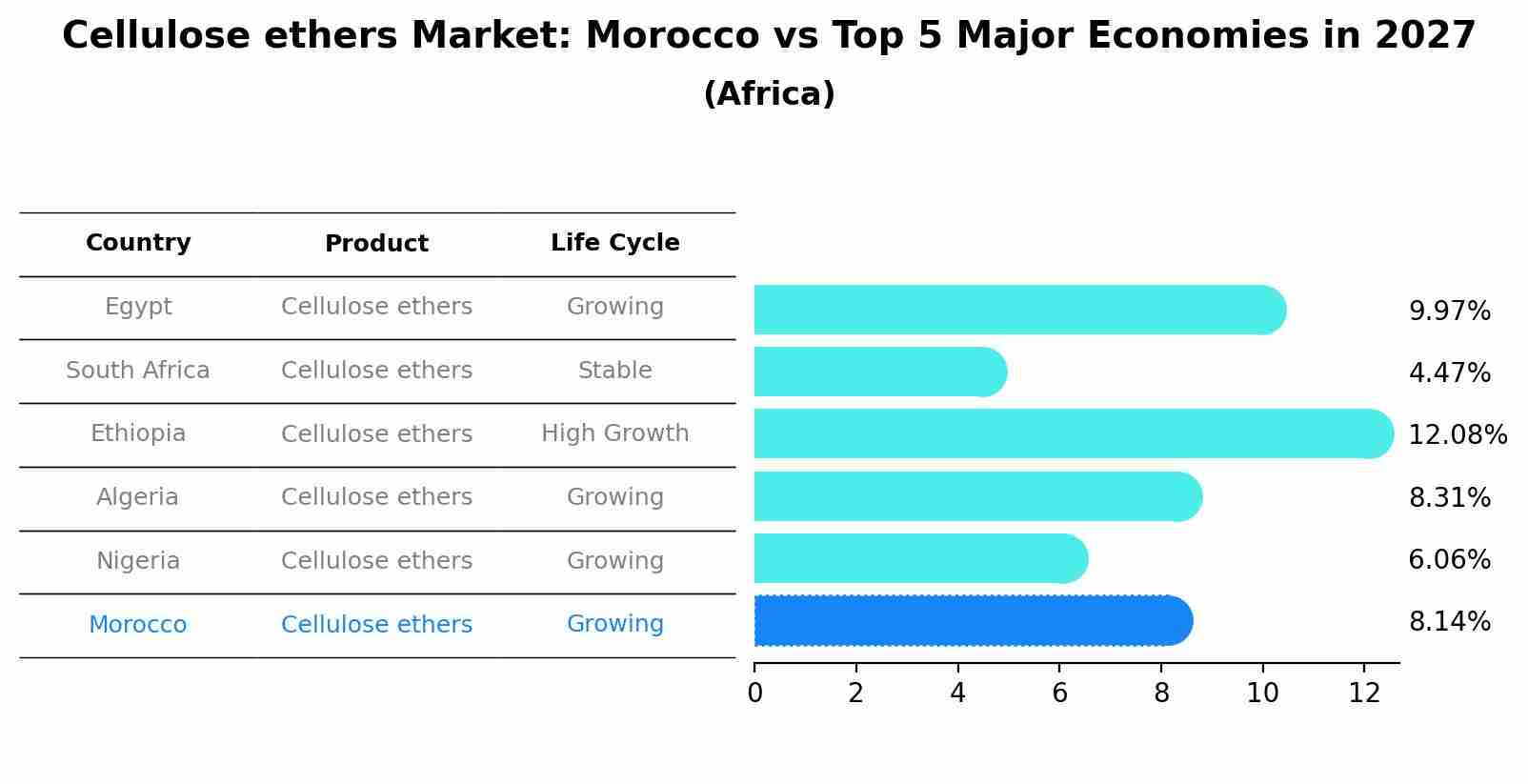Morocco Cellulose ethers Market Outlook | Revenue, Share, Forecast, Growth, Value, COVID-19 IMPACT, Analysis, Industry, Trends, Size & Companies
| Product Code: ETC093072 | Publication Date: Jun 2021 | Updated Date: Apr 2025 | Product Type: Report | |
| Publisher: 6Wresearch | Author: Ravi Bhandari | No. of Pages: 70 | No. of Figures: 35 | No. of Tables: 5 |
Morocco Cellulose ethers Market Size Growth Rate
The Morocco Cellulose ethers Market is projected to witness mixed growth rate patterns during 2025 to 2029. Starting at 6.86% in 2025, the market peaks at 8.14% in 2027, and settles at 6.85% by 2029.

Cellulose ethers Market: Morocco vs Top 5 Major Economies in 2027 (Africa)
In the Africa region, the Cellulose ethers market in Morocco is projected to expand at a growing growth rate of 8.14% by 2027. The largest economy is Egypt, followed by South Africa, Ethiopia, Algeria and Nigeria.

Morocco Cellulose ethers Market Synopsis
The cellulose ethers market in Morocco is expanding, with applications in pharmaceuticals, food and beverages, and construction. Cellulose ethers are used as thickeners, binders, and stabilizers due to their excellent solubility and biocompatibility. The market growth is supported by rising construction activities where cellulose ethers are used in mortars and adhesives, and by the pharmaceutical industry`s demand for safe excipients. Innovations in product formulations to enhance performance characteristics are a significant trend.
Drivers of the market
The cellulose ethers market in Morocco is propelled by their extensive use in the construction industry as thickeners, binders, and water retention agents in products like cement and plaster. The demand for high-performance construction materials that improve workability and durability drives market growth. Additionally, the use of cellulose ethers in pharmaceuticals, personal care products, and food industries adds to their market potential.
Challenges of the market
The Morocco cellulose ethers market faces challenges related to raw material availability, quality control, and market competition. Cellulose ethers are derived from cellulose, primarily sourced from wood pulp or cotton linters, making raw material availability and price fluctuations key concerns for manufacturers. Ensuring consistent product quality and performance characteristics across different batches and applications requires rigorous quality control measures, posing technical challenges for producers. Moreover, the market faces competition from alternative thickening, stabilizing, and film-forming agents, such as synthetic polymers and natural gums, which offer similar functionalities and may present pricing or performance advantages, requiring differentiation strategies to maintain market share.
Government Policy of the market
The cellulose ethers market benefits from government policies focusing on sustainable agriculture, construction, and pharmaceuticals. Regulations supporting the use of safe and sustainable additives in food, pharmaceuticals, and building materials drive the demand for cellulose ethers. Government investment in research and development and incentives for industries adopting eco-friendly practices play a significant role in market growth.
Key Highlights of the Report:
- Morocco Cellulose ethers Market Outlook
- Market Size of Morocco Cellulose ethers Market, 2024
- Forecast of Morocco Cellulose ethers Market, 2031
- Historical Data and Forecast of Morocco Cellulose ethers Revenues & Volume for the Period 2018 - 2031
- Morocco Cellulose ethers Market Trend Evolution
- Morocco Cellulose ethers Market Drivers and Challenges
- Morocco Cellulose ethers Price Trends
- Morocco Cellulose ethers Porter's Five Forces
- Morocco Cellulose ethers Industry Life Cycle
- Historical Data and Forecast of Morocco Cellulose ethers Market Revenues & Volume By Product Type for the Period 2018 - 2031
- Historical Data and Forecast of Morocco Cellulose ethers Market Revenues & Volume By Carboxymethyl Cellulose for the Period 2018 - 2031
- Historical Data and Forecast of Morocco Cellulose ethers Market Revenues & Volume By Methyl Cellulose & Derivatives for the Period 2018 - 2031
- Historical Data and Forecast of Morocco Cellulose ethers Market Revenues & Volume By Hydroxyethyl Cellulose for the Period 2018 - 2031
- Historical Data and Forecast of Morocco Cellulose ethers Market Revenues & Volume By Others for the Period 2018 - 2031
- Historical Data and Forecast of Morocco Cellulose ethers Market Revenues & Volume By Application for the Period 2018 - 2031
- Historical Data and Forecast of Morocco Cellulose ethers Market Revenues & Volume By Food and Beverage for the Period 2018 - 2031
- Historical Data and Forecast of Morocco Cellulose ethers Market Revenues & Volume By Pharmaceuticals and Healthcare for the Period 2018 - 2031
- Historical Data and Forecast of Morocco Cellulose ethers Market Revenues & Volume By Construction for the Period 2018 - 2031
- Historical Data and Forecast of Morocco Cellulose ethers Market Revenues & Volume By Cosmetics for the Period 2018 - 2031
- Historical Data and Forecast of Morocco Cellulose ethers Market Revenues & Volume By Personal Care for the Period 2018 - 2031
- Historical Data and Forecast of Morocco Cellulose ethers Market Revenues & Volume By Others for the Period 2018 - 2031
- Morocco Cellulose ethers Import Export Trade Statistics
- Market Opportunity Assessment By Product Type
- Market Opportunity Assessment By Application
- Morocco Cellulose ethers Top Companies Market Share
- Morocco Cellulose ethers Competitive Benchmarking By Technical and Operational Parameters
- Morocco Cellulose ethers Company Profiles
- Morocco Cellulose ethers Key Strategic Recommendations
Frequently Asked Questions About the Market Study (FAQs):
1 Executive Summary |
2 Introduction |
2.1 Key Highlights of the Report |
2.2 Report Description |
2.3 Market Scope & Segmentation |
2.4 Research Methodology |
2.5 Assumptions |
3 Morocco Cellulose ethers Market Overview |
3.1 Morocco Country Macro Economic Indicators |
3.2 Morocco Cellulose ethers Market Revenues & Volume, 2021 & 2031F |
3.3 Morocco Cellulose ethers Market - Industry Life Cycle |
3.4 Morocco Cellulose ethers Market - Porter's Five Forces |
3.5 Morocco Cellulose ethers Market Revenues & Volume Share, By Product Type, 2021 & 2031F |
3.6 Morocco Cellulose ethers Market Revenues & Volume Share, By Application, 2021 & 2031F |
4 Morocco Cellulose ethers Market Dynamics |
4.1 Impact Analysis |
4.2 Market Drivers |
4.3 Market Restraints |
5 Morocco Cellulose ethers Market Trends |
6 Morocco Cellulose ethers Market, By Types |
6.1 Morocco Cellulose ethers Market, By Product Type |
6.1.1 Overview and Analysis |
6.1.2 Morocco Cellulose ethers Market Revenues & Volume, By Product Type, 2021-2031F |
6.1.3 Morocco Cellulose ethers Market Revenues & Volume, By Carboxymethyl Cellulose, 2021-2031F |
6.1.4 Morocco Cellulose ethers Market Revenues & Volume, By Methyl Cellulose & Derivatives, 2021-2031F |
6.1.5 Morocco Cellulose ethers Market Revenues & Volume, By Hydroxyethyl Cellulose, 2021-2031F |
6.1.6 Morocco Cellulose ethers Market Revenues & Volume, By Others, 2021-2031F |
6.2 Morocco Cellulose ethers Market, By Application |
6.2.1 Overview and Analysis |
6.2.2 Morocco Cellulose ethers Market Revenues & Volume, By Food and Beverage, 2021-2031F |
6.2.3 Morocco Cellulose ethers Market Revenues & Volume, By Pharmaceuticals and Healthcare, 2021-2031F |
6.2.4 Morocco Cellulose ethers Market Revenues & Volume, By Construction, 2021-2031F |
6.2.5 Morocco Cellulose ethers Market Revenues & Volume, By Cosmetics, 2021-2031F |
6.2.6 Morocco Cellulose ethers Market Revenues & Volume, By Personal Care, 2021-2031F |
6.2.7 Morocco Cellulose ethers Market Revenues & Volume, By Others, 2021-2031F |
7 Morocco Cellulose ethers Market Import-Export Trade Statistics |
7.1 Morocco Cellulose ethers Market Export to Major Countries |
7.2 Morocco Cellulose ethers Market Imports from Major Countries |
8 Morocco Cellulose ethers Market Key Performance Indicators |
9 Morocco Cellulose ethers Market - Opportunity Assessment |
9.1 Morocco Cellulose ethers Market Opportunity Assessment, By Product Type, 2021 & 2031F |
9.2 Morocco Cellulose ethers Market Opportunity Assessment, By Application, 2021 & 2031F |
10 Morocco Cellulose ethers Market - Competitive Landscape |
10.1 Morocco Cellulose ethers Market Revenue Share, By Companies, 2024 |
10.2 Morocco Cellulose ethers Market Competitive Benchmarking, By Operating and Technical Parameters |
11 Company Profiles |
12 Recommendations |
13 Disclaimer |
- Single User License$ 1,995
- Department License$ 2,400
- Site License$ 3,120
- Global License$ 3,795
Search
Related Reports
- ASEAN Bearings Market (2025-2031) | Strategy, Consumer Insights, Analysis, Investment Trends, Opportunities, Growth, Size, Share, Industry, Revenue, Segments, Value, Segmentation, Supply, Forecast, Restraints, Outlook, Competition, Drivers, Trends, Demand, Pricing Analysis, Competitive, Strategic Insights, Companies, Challenges
- Europe Flooring Market (2025-2031) | Outlook, Share, Industry, Trends, Forecast, Companies, Revenue, Size, Analysis, Growth & Value
- Saudi Arabia Manlift Market (2025-2031) | Outlook, Size, Growth, Trends, Companies, Industry, Revenue, Value, Share, Forecast & Analysis
- Uganda Excavator, Crane, and Wheel Loaders Market (2025-2031) | Strategy, Consumer Insights, Analysis, Investment Trends, Opportunities, Growth, Size, Share, Industry, Revenue, Segments, Value, Segmentation, Supply, Forecast, Restraints, Outlook, Competition, Drivers, Trends, Demand, Pricing Analysis, Competitive, Strategic Insights, Companies, Challenges
- Rwanda Excavator, Crane, and Wheel Loaders Market (2025-2031) | Strategy, Consumer Insights, Analysis, Investment Trends, Opportunities, Growth, Size, Share, Industry, Revenue, Segments, Value, Segmentation, Supply, Forecast, Restraints, Outlook, Competition, Drivers, Trends, Demand, Pricing Analysis, Competitive, Strategic Insights, Companies, Challenges
- Kenya Excavator, Crane, and Wheel Loaders Market (2025-2031) | Strategy, Consumer Insights, Analysis, Investment Trends, Opportunities, Growth, Size, Share, Industry, Revenue, Segments, Value, Segmentation, Supply, Forecast, Restraints, Outlook, Competition, Drivers, Trends, Demand, Pricing Analysis, Competitive, Strategic Insights, Companies, Challenges
- Angola Excavator, Crane, and Wheel Loaders Market (2025-2031) | Strategy, Consumer Insights, Analysis, Investment Trends, Opportunities, Growth, Size, Share, Industry, Revenue, Segments, Value, Segmentation, Supply, Forecast, Restraints, Outlook, Competition, Drivers, Trends, Demand, Pricing Analysis, Competitive, Strategic Insights, Companies, Challenges
- Israel Intelligent Transport System Market (2025-2031) | Strategy, Consumer Insights, Analysis, Investment Trends, Opportunities, Growth, Size, Share, Industry, Revenue, Segments, Value, Segmentation, Supply, Forecast, Restraints, Outlook, Competition, Drivers, Trends, Demand, Pricing Analysis, Competitive, Strategic Insights, Companies, Challenges
- Uganda Precast and Aggregate Market (2025-2031) | Strategy, Consumer Insights, Analysis, Investment Trends, Opportunities, Growth, Size, Share, Industry, Revenue, Segments, Value, Segmentation, Supply, Forecast, Restraints, Outlook, Competition, Drivers, Trends, Demand, Pricing Analysis, Competitive, Strategic Insights, Companies, Challenges
- Australia IT Asset Disposal Market (2025-2031) | Strategy, Consumer Insights, Analysis, Investment Trends, Opportunities, Growth, Size, Share, Industry, Revenue, Segments, Value, Segmentation, Supply, Forecast, Restraints, Outlook, Competition, Drivers, Trends, Demand, Pricing Analysis, Competitive, Strategic Insights, Companies, Challenges
Industry Events and Analyst Meet
Our Clients
Whitepaper
- Middle East & Africa Commercial Security Market Click here to view more.
- Middle East & Africa Fire Safety Systems & Equipment Market Click here to view more.
- GCC Drone Market Click here to view more.
- Middle East Lighting Fixture Market Click here to view more.
- GCC Physical & Perimeter Security Market Click here to view more.
6WResearch In News
- Doha a strategic location for EV manufacturing hub: IPA Qatar
- Demand for luxury TVs surging in the GCC, says Samsung
- Empowering Growth: The Thriving Journey of Bangladesh’s Cable Industry
- Demand for luxury TVs surging in the GCC, says Samsung
- Video call with a traditional healer? Once unthinkable, it’s now common in South Africa
- Intelligent Buildings To Smooth GCC’s Path To Net Zero













